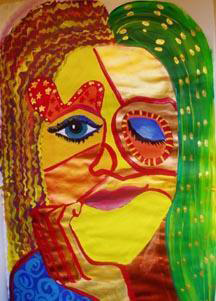Goal (Terminal Objective):
Working from direct observation, students will create an expressive selfportrait.
Objective:
Thinking about their individual personalities and immediate mood, students will create an expressive selfportrait painting from direct observation. Use of color is a key element in visually depicting their inner self.
National Standards:
Visual Arts Grades 9-12 Content Standard 1: Understanding and applying media techniques, and processes
Visual Arts Grades 9-12 Content Standard 3: Choosing and evaluating a range of subject matter, symbols, and ideas
Visual Arts Grades 9-12 Content Standard 4: Understanding the visual arts in relation to history and cultures
Visual Arts Grades 9-12 Content Standard 5: Reflecting upon and assessing the characteristics and merits of their work and the work of others
Purpose:
Students will use aesthetic scanning to view and discuss examples of expressive portraiture. Students will understand how to visually depict mood and feeling – sensory qualities in a work or art. Students will gain technical proficiency in using acrylic paint. Students will apply creative problem solving through the unique personality expressed in their final portrait painting.
New Vocabulary:
sensory, selfportrait
Materials:
white drawing paper, Bristol, and the following Sargent Art supplies:

#24-2499 Acrylic Paint
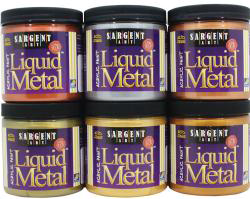
#22-1106 Metallic Acrylic Paint
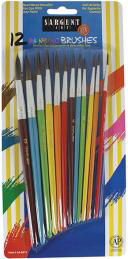
#56-6012 Natural Hair Rainbow Brush Assortment

#22-7244 144 ct. Graphite Pencils

#90-3000 Canvas Panels
Time:
approximately 45 class periods
Introduction and Motivation (Set):
Begin by showing students examples of expressive portraits and other examples of selfportraits. Picasso, Modigliani, Frida Kahlo, and Vincent Van Gogh all offer good examples of portraiture and selfportraiture. Discuss with students why artists choose to make selfportraits. What types of things about oneself can be expressed through selfportraiture? Discuss with students the aesthetics of color and how it affects mood and feeling expressed through a painting.
Instruction:
- Using direct observation, students do a pencil drawing of their self portrait; changing and abstracting along the way to express their expressive final visualintentions.
- Students choose expressive colors and begin painting their portrait. Encourage wet on wet blending directly on the paintedsurface.
- Once areas are blocked in with color, students can build up details and patterns in areas. Suggest students try using other objects dipped in paint to create patterns and textures
- Upon completion, students may choose words to accompany the mood and feeling (sensory aspects) they are visually depicting in theirportrait.

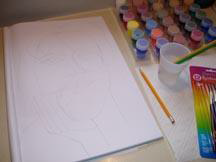
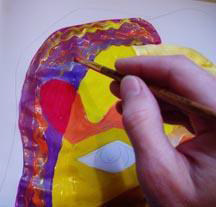 wet on wet blending directly on the painted surface
wet on wet blending directly on the painted surface
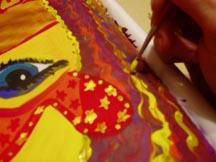 detail being added withpaintbrush
detail being added withpaintbrush
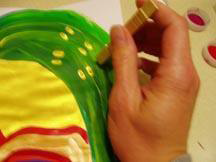 detail being added with clothespin dippedin
detail being added with clothespin dippedin
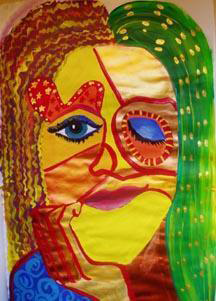 serenity, peace, playfulness, free spirit, warm, dreamy
serenity, peace, playfulness, free spirit, warm, dreamy
expressive words used to describe completed selfportrait
Activities:
(1) Guided Practice:
a. Students use aesthetic scanning to view fine art examples of expressive portraits andselfportraits.
b. Students visually analyze and discuss artists’ choices of colors to depict mood and feeling in a painting (sensoryaspects).
c. Students use direct observation to draw a selfportrait, altered to become abstracted andexpressive.
d. Students make individual creative choices of color to express sensory aspects in theirpaintings.
e. Students demonstrate overall creative problem solving throughoutthe completion of their expressiveself-portraits.
(2) Independent Practice and Check for Understanding:
a. Teacher circulates and helps students withdrawing.
b. Teacher offers individual help with color choices and questions about sensory qualities in a work ofart.
c. Teacher asks students questions as they work, such as – “What mood do you hope to convey in your portrait?” or “What type of colors will help express the tone of theportrait?”
(3) Closure:
a. Students can create a nicely lettered label with their choice of expressive words to accompany their completedpaintings.
b. It’s fun to have students choose expressive words for one another’s paintings before the individual artist reveals their personalchoices.
Evaluation:
Level One — The finished selfportrait very successfully demonstrates the student’s understanding of personal expression and objective abstraction. The initial drawing is executed very well. The student has shown strong technical skills in using the medium of acrylic paint. The student has shown a high level of creativity in completing the portrait with individual personality. Craftsmanship is outstanding.
Level Two — The finished selfportrait demonstrates the student’s understanding of personal expression and objective abstraction. The student has shown good technical skills in using the medium of acrylic paint. The student has shown creativity in completing the portrait with individual personality. Craftsmanship is good.
Level Three — The finished selfportrait shows limited understanding of personal expression and objective abstraction. The student has limited technical success with using the acrylic paint medium. Creativity and craftsmanship is minimal.
Level Four — The finished selfportrait shows no understanding of personal expression and objective abstraction. The initial drawing is done poorly. The technical skill shown through the use of acrylic paint is weak. Creativity, effort, and craftsmanship are poor.
Extension:
Teacher could instruct students to include symbolic representation of themselves in the portrait, and discuss iconography with the class.
Resources:
http://www.abcgallery.com/P/picasso/picasso116.html
http://www.globalgallery.com/enlarge/02838899/
http://abcgallery.com/M/modigliani/modigliani.html
Art Consultant



